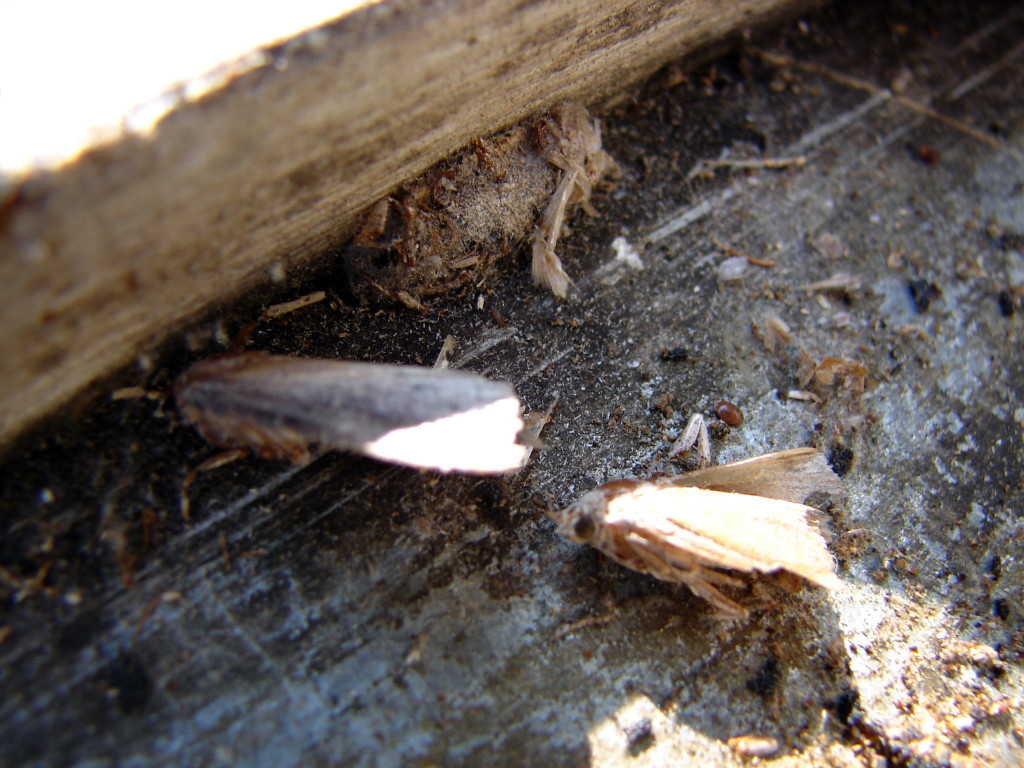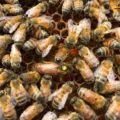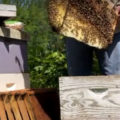There’s a lot of information that can be gained by taking a closer look at something we might usually disregard. Particularly, the boards on the bottom of our bee hive. Listen to me… I have screen bottom boards in the bottoms of my hives… so what am I talking about?
Today, I paid another visit to Jim and Cindy’s apiary for a hands-on look at some of the fodder that falls to the bottom of the hive. Call it a lunch date with a bee, a mite and a wax moth if you will. Anyway, at first glance, the bottom board looks quite disgusting. Just look at all those crunchies on it.

After a closer second look, I’m thinking about the crust I put on top of my zucchini casserole. Mmmmm.
But really, there’s more to be gained here than the next recipe idea. Were talking about determining if and when we should take action against the parasites that inhabit our hives. Varroa mites, in small numbers may not be reason enough for concern, but if we noticed a climb in these numbers, what would we do? How many is too many? Are we really looking anyway? These are the questions whose answers are many. Ever notice you can’t get a straight answer out of someone when you ask? Usually, it’s because it may vary from one area to another. Or perhaps one beekeeper has a particular threshold before they worry about mites. Maybe one hive is more hygienic than another.
Here’s how Jim and Cindy do it. Take a look at this image. Jim has drawn a line across the width of his board and he and Cindy count the mites on one half of the board. Read below as Cindy describes when they will take action.

“We will count 100 mites over a one day drop on an average-sized two-story beehive. When we have a really huge hive, that number might be bigger. When we have a small, one-story hive, it’s lower. The last couple years, I’ve been doing a 2-3 day drop count, and dividing to get a daily average. I think this gives you a truer count. You also want the count to be over a period of time when you are not in there thrashing around and stirring things up. We usually scrape the sticky boards after we are done in the apiary, then 2-3 days later, I go out, count and get my average daily drop.”
This advice to me is good for my own basis. I will do this until there’s a more compelling reason to change it. How we take action against mites is determined by our beliefs on what should and shouldn’t go in to a hive. Most of our members employ more natural approaches. Some may be strict about this, while others may actually submit to chemicals. Here are three more natural approaches to mite control listed from least to most effort; tobacco smoke (arguably, less-natural,) Sugar dusting, or the Mel Disselkoen outbreeding approach. Don’t let the complexities of the approach discourage you. We only want to share this information to better arm you for when you may need to take action. I’m in my first year hives and I have not found a mite yet. I have however found wax moth larva and a few hive beetles. None seems to have affected the productivity of either hive, yet.
See the images below to view the gallery of images I took between Jim’s and my own hives. Hopefully, the images will help new beekeepers identify mites and wax moth larva as well give an indication of their relative size. I’ll follow up on this blog with more details and I uncover them but I’m hoping a few more seasoned beekeepers will chime in on some information to add. More later.













I noticed that on the photo with the wax moth coming out (on the last pic posted ) some of the debris looks like black ovals ( maybe poop from the moth ) Is that what it is ?
Jesse, yes, I think that’s just what it is. Nice observation.
Ive looked everywhere! But cannot find what this stuff is in my tray its like saw dust but finer a pile of it and you can see through it. [email protected]